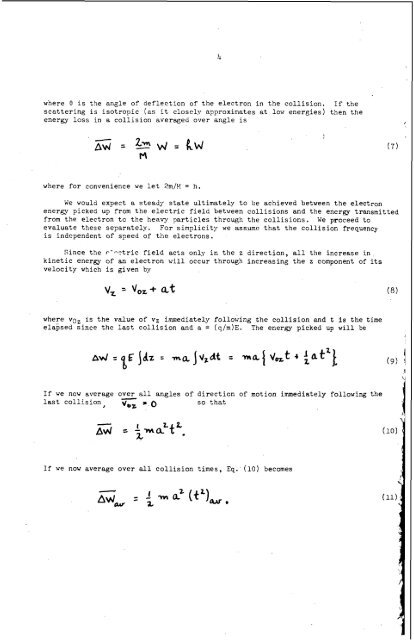chemical physics of discharges - Argonne National Laboratory
chemical physics of discharges - Argonne National Laboratory chemical physics of discharges - Argonne National Laboratory
4 where 0 is the angle of deflection of the electron in the collision. If the scnttering is isotropic (as it close1.v approximates at low energies) then the energy loss in a collision averaged over angle is , where for convenience we let 2m/M = h. We would expect a steady state ultimately to be achieved between the electron energy picked up from the electric field between collisions and the energy transmitted from the electron tc the heavy particles through the collisions. We proceed to evaluate these separately. For simplicity we assume that the collision frequency is independent of speed of the electrons. Since the r'--tric field acts only in the z direction, all the increase in kinetic energy of an electron will occur through increasing the z component of its velocity which is given by where voz is the value of vz immediately following the collision and t is the time elapsed since the last collision and a = (q/m)E. The energy picked up will be If we now average over all angles of direction of motion immediately following the last collision, '-0 so that If we now average over all collision times, Eq. (10) becomes I (9) I , 1
4 I I 5 To find (t2)av, we assume that collisions are random events and the collision frequency is independent of speed. We can then write that the probability of a collision occurring in the interval t to t + dt following the precdding collision is . . for which the average value of t2 is 2@ where< = 112 is the mean collision time. Eq. (11) then becomes a&# t2. = ma-t If we also average over all speeds of electrons and neglect some of the finer pohts of statistics, Eq. (13) becomes where A is the mean free path and c is the mean speed of the electrons. This quantity, in the steady state, will equal the right hand side of Eq. (7) averaged over all electrons. If we let d.ls 1 -2 c 2 Thus we would expect that the mean speed would be given by - and the mean energy of the electrons in the steady state by (13)
- Page 1 and 2: )i 1 reesonably complete and accura
- Page 3: 3 inquire about the component of ve
- Page 7 and 8: \ vnich, it is noted can be negativ
- Page 9 and 10: I 7 than or smaller than the second
- Page 11 and 12: i I i I I I ) ) i L , I I . INT1:OD
- Page 13 and 14: 13 field per electron is and per co
- Page 15 and 16: . 11. 5. CharRe-Transfer and Ion-Mo
- Page 17 and 18: 17 In the followin:: sections much
- Page 19 and 20: above. With that EIN, an estimate o
- Page 21 and 22: 21 region in w!iich large, nighlv l
- Page 23 and 24: i ’ understanding: 23 (a) Electro
- Page 25 and 26: Obviously, the secondary ion must h
- Page 27 and 28: 27 (22) Franklin, J. L., Munson, M.
- Page 29 and 30: Tables 1-6 present examples of rela
- Page 31 and 32: Table 8 Some Ions Formed by Process
- Page 33 and 34: 33 velocity of the reacting partn r
- Page 35 and 36: 35 must be added to the Langevin cr
- Page 37 and 38: 37 In our laboratory a microwave di
- Page 39 and 40: + . 4 . r 39 as well as N in a cor0
- Page 41 and 42: ION-MOIECULE REACTION RATES MEASUFI
- Page 43 and 44: 43 excitntion 2onditions so that th
- Page 45 and 46: 45 In 2 like manner Fig. 3, showing
- Page 47: 47 Absorption Spectra of Transient
- Page 50 and 51: 50 maximum fiela. In this manner, a
- Page 52 and 53: 52 3 % %- %- 5- a- 7 h W P H 0 L v)
4<br />
where 0 is the angle <strong>of</strong> deflection <strong>of</strong> the electron in the collision. If the<br />
scnttering is isotropic (as it close1.v approximates at low energies) then the<br />
energy loss in a collision averaged over angle is ,<br />
where for convenience we let 2m/M = h.<br />
We would expect a steady state ultimately to be achieved between the electron<br />
energy picked up from the electric field between collisions and the energy transmitted<br />
from the electron tc the heavy particles through the collisions. We proceed to<br />
evaluate these separately. For simplicity we assume that the collision frequency<br />
is independent <strong>of</strong> speed <strong>of</strong> the electrons.<br />
Since the r'--tric field acts only in the z direction, all the increase in<br />
kinetic energy <strong>of</strong> an electron will occur through increasing the z component <strong>of</strong> its<br />
velocity which is given by<br />
where voz is the value <strong>of</strong> vz immediately following the collision and t is the time<br />
elapsed since the last collision and a = (q/m)E. The energy picked up will be<br />
If we now average over all angles <strong>of</strong> direction <strong>of</strong> motion immediately following the<br />
last collision, '-0 so that<br />
If we now average over all collision times, Eq. (10) becomes<br />
I<br />
(9) I ,<br />
1



